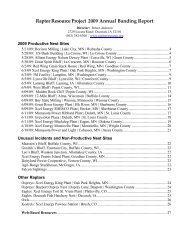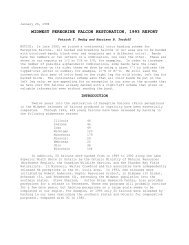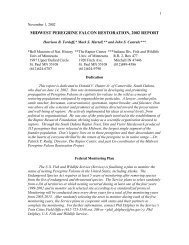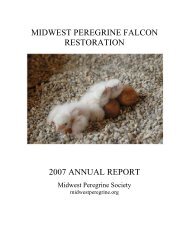2006 - Midwest Peregrine Falcon Restoration Project
2006 - Midwest Peregrine Falcon Restoration Project
2006 - Midwest Peregrine Falcon Restoration Project
You also want an ePaper? Increase the reach of your titles
YUMPU automatically turns print PDFs into web optimized ePapers that Google loves.
57<br />
lens when extended fits inside the scope eyecup a bit loosely. To make the fit more snugly, I put a<br />
strip of thin leather four inches long and a quarter inch wide inside the eyecup as a bushing for the<br />
camera lens<br />
A sturdy tripod is essential and a remote shutter release is almost as essential. Any movement<br />
of the camera during exposure is likely to ruin the image.<br />
Given this equipment (and I eagerly await suggestions from anyone for equipment<br />
improvements), how is it best used in the field First, the camera (my Nikon 8400, that is) should be<br />
set on shutter control, which automatically opens autofocus. Then zoom it to its 3.5X optical limit to<br />
avoid “vignetting”, an automatic framing of the scope image as viewed on the camera monitor at<br />
lower camera magnifications. The zoom range of my telescope is 20X to 60X. For years I thought<br />
that 40X to 50X produced the best result, usually a compromise between image size and image<br />
readability. Recently, I have experimented with 60X, at the suggestion of Jackie Fallon, and find that<br />
this works fine if the focus is precise. How precise With an image in clear focus at 60X on my<br />
scope, moving the fine focus adjustment wheel either way less than a millimeter destroys the focus.<br />
Focus the scope directly on the bird and then mount the camera, delicately. At 3.5X camera zoom<br />
and 40X scope zoom, the net result is an image enlarged 140 times; at 3.5X and 60X, 210 times.<br />
To minimize blurring by falcon or camera movements, shutter speed should be as fast as<br />
provides a reasonably lighted image. With my equipment, shutter speeds of 1/125 th or 1/250 th second<br />
seem to work best. Poor light may call for slower shutter speeds, enhancing the value of the remote<br />
shutter release to avoid camera movement.<br />
Given good light, patience, and a cooperative falcon that exposes its banded leg at least<br />
occasionally, how far away should an image enlarged 140X or 210X be readable I tested the ability<br />
of several people with good eyesight to read peregrine black/green bands in outdoor Minnesota








